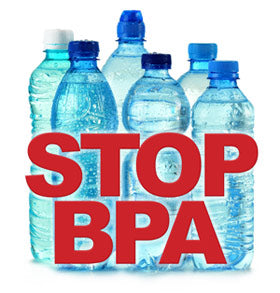A Summary of Several Major Medical Studies of Chemicals in Plastics Unless we live next to a pristine lake or an unspoiled stream somewhere high up on a mountain rarely touched by human civilization, we have to consider—and perhaps even worry about—what type of containers and bottles to use for storing the filtered RO water. In essence, we cannot truly enjoy pure clean water without having to think about the question of what type of clean containers we should use. If we fill a toxin-laden bottle known to leach harmful chemicals into its content with the purest water found on Earth, what is the use of having that purest water? Concerned we should. We simply cannot ignore this important question of what type of container and bottle to use for storing our food and water.

Since April 2008 when the Canadian government announced a ban of BPA-containing Nalgene and polycarbonate plastic water bottles for babies, polycarbonate bottles have been in the mainstream national news. BPA is the acronym for Bisphenol A, a monomer used to produce polycarbonate plastic, the resin lining of food can, and many other products, with an annual global manufacturing capacity exceeding 6.4 billion pounds (Environmental Health Perspectives journal, August 2005). It is revealed in an analysis of BPA that the ester bonds in the BPA-based polymers are subject to hydrolysis (heat and contact with acidic and basic compounds can accelerate the hydrolysis of BPA), thereby leaching BPA into food and water and leading to widespread human exposure. BPA is used to harden plastics, making the transparent and colorful Nalgene-type water bottles virtually shatterproof and unbreakable. Considered an "environmental estrogen," BPA can trigger a whole host of diseases in animals and humans. The chemical structures of polycarbonate and Bisphenol A are presented as follows:
According to the New York Times (2008), the United States Environmental Protection Agency (EPA) has approved some 80,000 chemicals for consumer use, citing a statistic published by the Center for Children's Health and the Environment. Of those 80,000 approved chemicals, 2,800 are manufactured in large volumes of more than one million pounds per year. But fewer than half of those high-volume consumer-use chemicals have been studied for their toxicity and health effects in animals or humans.
Human Exposure of BPA in Japan and the United States
Keep in mind that BPA exposure in ordinary Americans is so widespread that the U.S. Centers for Disease Control and Prevention (CDC) found that 95% of urine samples from Americans have "measurable BPA levels" (Calafat el al., Environmental Health Perspective, 2005). In 1992 and 1999 in Japan, researchers found that 92% and 87.5% of university men tested have BPA in their urine (Arakawa et al., Environmental Health Prevention Med., 2004). So what are the consequences of having BPA in our blood and tissue?
BPA has been extensively and thoroughly studied in the past 20 years by scientists and researchers. However, the government has not been acting on its findings. Until April and May of 2008 when the Canadian government announced its plans to ban BPA-polycarbonate baby bottles, the health authorities and departments in the United States paid little attention to this issue. So how dangerous is BPA to humans and animals? We surveyed a few key medical research studies published in academic, peer-reviewed journals and present a summary of their findings here.
Risks of BPA in Medical and Environmental Research
Just how dangerous is BPA to animals and humans? The following risks of BPA-containing plastics have been published in medical and environmental literature in the past two decades:
- As of December 2004, there were 115 published in vivo studies of low-dose BPA exposure, with 94 studies showing significant effects, such as the disruption of cell functions. (von Saal and Hughes, Environmental Health Perspectives, August 2005)
- In Japan and in the United States, researchers have found that BPA accounted for the most estrogenic activity that leaches from municipal landfills into the surrounding ecosystems (Kawagoshi et al., Japan Environmental Monitoring, 2003; Coors et al., Environmental Science and Technology, 2003)
- Japanese researchers have found that BPA can disrupt thyroid hormone action. (Moriyama et al., Japan Clinical Endocrinology Metabolism, 2002) Other researchers have confirmed this finding. (Zoeller et al., Endocrinology, 2005)
- Scientists have found that very low parts-per-trillion doses of BPA can cause expansion of human prostate cancer cells through binding to a mutant form of the androgen receptor expressed in a subpopulation of prostate cancer cells (Wetherill et al., Molecular Cancer Therapy., 2002)
- BPA has been found by medical researchers to block testosterone synthesis (Akingbemi et al., Endocrinology, 2004)
- Scientists found that BPA can alter basic cell function at extremely low doses of below 1 part-per-trillion (ppt): In breast tumor MCF-7 cells of rats, BPA stimulated calcium influx at low doses of 23 ppt. (Walsh et al., Molecular Cell Endocrinology, 2005) But at the lowest dose tested, 0.23 ppt, researchers found that BPA also stimulated calcium influx and prolactin secretion in rat pituitary tumor cells. (Wozniak et al., Environmental Health Perspectives, 2005)
- The environmental BPA exposure may block the effects of estrogen on certain types of brain cells, indicating that chronic exposure to BPA might interfere with estrogen effects on brain development and function, inhibiting normal sex differences in cognitive function and other non-reproductive behavior. (MacLusky et al., Environmental Health Perspectives, 2005)
These risks are just a sampling of the hundreds of scientific research articles published in the past two decades in the United States, Europe, and Japan. For your health, we suggest that if you are using polycarbonate plastic water bottles currently, consider switching to glass, ceramic, or stainless-steel bottles and containers. It's better to be safe than sorry!



